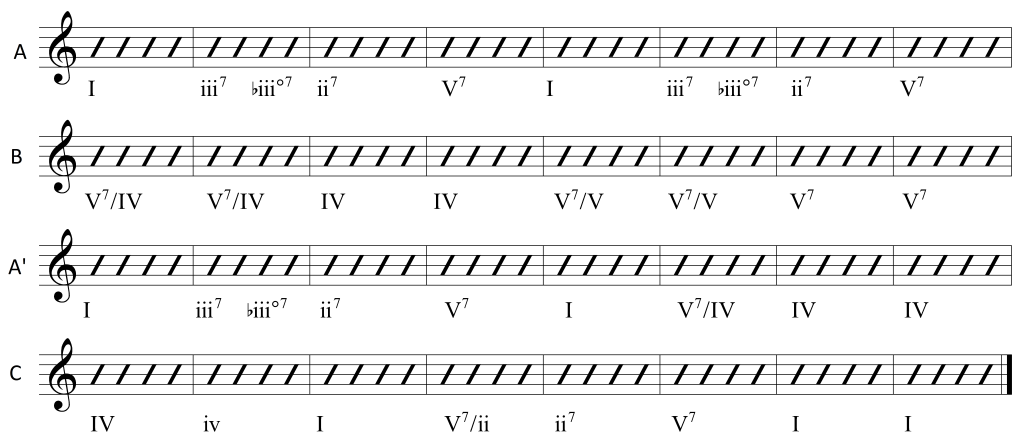46 Form in Jazz Standards
The formal structure of the American Songbook is the 32-bar song form. It consists of four 8-measure sections.
A. Bridge Form
A A’ B A. The A section is repeated by a slightly varied A’ section. The B section, called the bridge, often touches on a closely related key. The A section rounds off the form.

An example of bridge form:
Practice
Obtain the lead sheet and analyze the harmonic and formal structure in Billy Strayhorn’s “Take the A Train.”
B. Bridgeless Form
A B A’ C. A pair of contrasting sections is followed by a slightly varied A’ section. A new C section completes the form.

An example of bridgeless form:
Another bridgeless form variant is A B A B’.
Practice
Obtain lead sheets and study the harmonic and formal structures in Arthur Johnston’s “Pennies from Heaven” and Johnny Mandel’s “The Shadow of Your Smile.”
C. The ii7 – V7 – (Imaj7) Mosaic Technique
Standards often are structured using a “mosaic” technique of ii7 – V7 or ii7 – V7 – Imaj7 links borrowed from different keys that move up or down by whole steps, half steps, or other intervals. These mosaics of keys allow the improviser to instantly create improvised melodies in these keys. The mosaics do not constitute a modulation; the section starts and ends in the same key.
The example below uses ninth chords.
Practice
Obtain the lead sheet and analyze the harmonic and formal structure in Duke Ellington and Billy Strayhorn’s “Satin Doll.”
D. The Diatonic Sequence in Minor
Standards and popular songs often employ the diatonic sequence (imperfect circle of fifths). The sequence below is in natural minor using ninth chords. Note the dominant V![]() 9 and the iiø7 with the doubled root.
9 and the iiø7 with the doubled root.
Practice
Obtain the lead sheet and analyze the harmonic and formal structure in Bart Howard’s “Fly Me to the Moon” and Joseph Kosma’s “Autumn Leaves.”